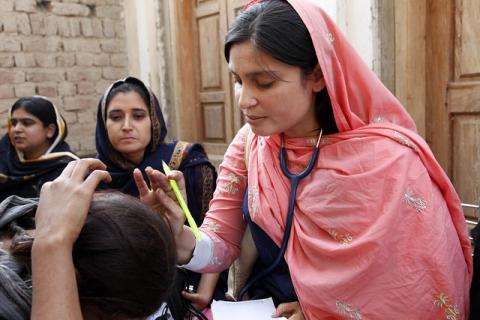Cooperation and engagement for a polio-free world

“We are so close to ending the polio” and “Still 15 years to a polio-free world” are not contradictory statements. They instead describe, with different degree of optimism, the current framework and the objective to be pursued in the fight against this disease. In other words, we are closer than ever to the target of a world free of polio, but much remains to be done to carry the world across the threshold. Polio eradication is the next issue public health authorities will be committed to in midterm future. Such an intervention has only one precedent – namely smallpox eradication – which goes back to 36 years ago. The European Region has been polio free since 2002. But no country can be considered absolutely safe until the virus has been eradicated globally. All the stakeholder involved in public health also need to be fully aware that as long as a single child in the world will be infected by the virus, all children over the world are at risk.
Among the three types of wild poliovirus (WPV), type 1 is still endemic in some areas of Pakistan and Afghanistan, where local persisting conflicts hinder effective immunization programmes. Another source of risk comes from polioviruses contained in oral polio vaccine (OPV). They are derived from WPVs and have undergone manipulation for the vaccine production that results in genomic instability and tendency to revert to strains similar to WPVs, more fit to survive. Some of these revertant virus are called vaccine-derived poliovirus (VDPVs) and circulate in the population occasionally causing polio outbreaks. In 2015, they were detected in several countries in 2015, including Ukraine. To eliminate any risk of polio due to VDPVs, OPV need to be phased out globally.
Europe is currently protected thanks to high vaccine coverage rates. But an avoidant or even hostile attitude towards vaccinations is growing, together with the misconception that certain diseases – like polio itself – belong to the past. This results in a trend that leads to exemption, whose direct consequences are the emergence of pockets of low vaccination coverage and the occurrence of outbreak of otherwise preventable infectious disease. As far as polio is concerned, an outbreak among unvaccinated persons who were members of a religious groups refusing vaccinations was reported in 1992 in the Netherlands. It has to be emphasized that where coverage rates decline, just a single traveler from an infected area might reintroduce the virus into a polio free country. This is not far from reality in a world where international travel is commonplace and Europe is called to welcome/host thousands of refugees, the most with an unknown vaccination status. And, again, this shows the relevance of a comprehensive approach to complete the Polio Eradication and Endgame Strategic Plan involving a broad range of stakeholders at the global, regional and national levels, including country governments, partners, other global health initiatives, technical advisory bodies, agencies involved in polio eradication, academics, civil society organizations, private industry.
However, there are also good news, even if at present their extraordinary extent was not adequately perceived by the media: in September 2015, wild poliovirus type 2 (WPV2) was declared eradicated with no cases since 1999 and this declaration will be made official in May at the 69th World Health Assembly (WHA). Moreover, as cases of wild poliovirus type 3 (WPV2) has not been found anywhere in the world for three years, the hypothesis of its eradication by the current year does not suffer from over-optimism. The eradication of WPV2 has to be considered a major breakthrough because it represents the precondition for the switch from trivalent OPV, containing all attenuated (weakened) poliovirus types, to bivalent OPV, containing types 1 and 3, and for the introduction of at least one dose of inactivated polio vaccine (IPV), containing all “killed” types, into the routine immunization schedule. The switch is a globally synchronized process involving countries that have used OPV alone or in combination with IPV – approximately two thirds of countries in the world – which has taken place in April 2016. It preludes to the removal of all OPVs vaccines, once obtained the eradication of types 1 and 3. This removal is a crucial step needed to eliminate the marginal risks of disease from VDPVs. WHO European Region is partially engaged in the switch due to the wide use of IPV for intramuscular injection.
Notably, all efforts leading to eradication are meaningless unless accompanied by an activity of containment. In fact, to prevent reintroduction of poliovirus, it is crucial to identify facilities holding wild or vaccine-derived viruses, destroy the most specimens and appropriately contain them in very few high security facilities necessary to perform the critical functions of vaccine production, diagnosis and research. In summary, in 2016 – as of April 26th – only 12 cases of polio have been reported, all from type 1 (WPV1). Another 15 years of activity separate us from the goal of polio free world, a major public health achievement that will benefit all people equally, regardless of the country in which they live. Admitting that last case is seen in 2016, the agenda will be: polio eradication certified in 2019, OPV withdrawal by 2020, polio vaccination withdrawal by 2025, surveillance interrupted by 2030.
Donato Greco
ECDC Consultant, Vaccine-preventable Diseases Programme
On behalf of ASSET project
